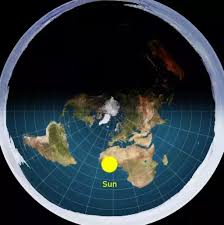
The curve of the Earth can be observed by experimenting with the horizon over varying distances. However, we have additional proof of Earth's roundness in the rising and setting of the sun. If the Earth was flat and the sun was always above the plane of the Earth, then why is it's light not always visible and why can we not see it?
Some flat Earth theorists claim it's because of the rule of perspective and vanishing point. The theory states that the sun is not visible because the further away the sun gets, the more the sun merges and disappears at the vanishing point. Think of this vanishing point as the photos of a long street, where the phone poles all converge towards the center of your vision. This is how perspective works.

But why doesn't the sun light keep traveling even though it's still present and above the Earth? After all, the issue is not with an actual disappearance of the sun but on our inability to view it properly from a distance. Even if the sun was too far away to see, the light should still light up the earth. At a minimum, it would at least cast a light shadow that shows the angle of the sun relative to an object. While it is not strong enough to "light up" the night time locations, it would not completely and 100% disappear. Yet, at night was can see that the shadows produced are from the moon and not the sun.
The flat earth model shows that the sun only lights up a portion of the earth at once. They claim that the sun rays only travel a few thousand miles at best. Here is the problem with that claim. Even if we concede (and we don't) that the sun can only light up a portion of the earth at a time, we should still be able to pull out a scope and bring the sun back into focus. Much like the moon is still visible even though the earth is very dimly lit by the moon light. Moreover, what is the phenomenon that is preventing the sun's rays from traveling further? If we can see planets and stars that are much further out than the sun (in the flat earth model) then why cannot we not see the "local sun hovering just over our disc? In order to believe this disappearance of light rays we also have to formulate a new theory of relativity and work out a new version of how the human eye works. Anything that we can visually see must be a source of light or reflect light. Our eyes are basically light receptors. Thus, if we can see objects further than the sun (like another planet) then there is no reason why we could not see the sun also.
The globe earth model is born out by easy to prove tests. Right after the sun sets, I can climb a tower and bring the sun back into view. That is because the sun is not disappearing just because its far away. It's disappearing because it's behind the horizon. With the theory that the sun that is simply out of range, climbing a tower at sun down would result in me just getting winded and a big letdown.
Even more perplexing is why the sun disappears so suddenly and why it always disappear from the bottom? Wouldn't it just get progressively smaller until it is too small to see? Objects don't change shape at the vanishing point. They just get too small to see but maintain their shape. We should see the sun exponentially increased in size while overhead and get smaller and smaller as it moves away from us.
The fact that the sun is about the same size all day long completely eliminates the perspective theory.
A final note should be made on the fact that from certain locations the sun can be viewed for a 24 hour period while on the opposite end of the globe it can be viewed just an hour or two at a time. This supports a tilted and spinning globe model. The flat Earth theory tries to account for this by saying the sun's orbit around the center of the flat earth has a varying radius. Meaning the sun oscillates closer and further from the center of the earth throughout the year. This is how they also explain the seasons. However, for this to work the sun's rays would have to have a very short throw. For example, in the picture below the sun only illuminates a local area.

The problem with this model is that we know from experience that the sun actually lights up roughly 1/2 of the globe at a time. It would look a lot more like the following model, based on known time zone observations.

Comments